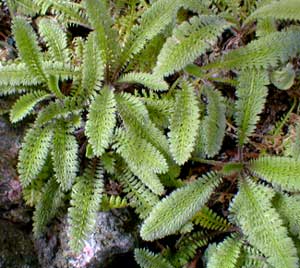 Brass Buttons:
Brass Buttons:
iddy biddy ferny-looking thingy
At the slightly sunnier head of a shade-path, near the Akebia arbor, we planted Brass Buttons (Leptinella squalida, still sometimes sold or listed by its former name Cotula squalida) as a semi-treadable half-inch-tall groundcover between flagstones. It spread rapidly by runners, so that it & its close relative L. reptans have occasionally been called "Creeping Cotula," a name likely to continue to fade from usage now that it has been recategorized Leptinella.
Brass Buttons spreads aggressively with runners over the surface or just underground. At its bushiest it reaches a scant one or two inches of height. Its feathery dull-green leaves look like the tiniest possible ferns. It isn't really a fern, but is a diminuative relative of the sunflower. It likes part shade but does well in sun.
Though it is often described as an evergreen in USDA Zone 9, here on Puget Sound (Zone 8) it dies back almost completely by mid-winter. As a native of temperate New Zealand, I would suppose its behavior here is the same as in its native habitat, which is definitely not evergreen. Its specific habitat would be subalpine, so it is hardy to Zone 4, though labels that promise it will be evergreen are disengenuous.
Ours dies down to very little remaining by December, then leaps back to life by late April. It begins to flower in May & there will be some tiny yellowish green chamomile-like flowers on it well into summer. Although these are somewhat interesting blooms if given close inspection, as they do look like the centers of sunflowers stripped of petals, they are in general not very noticeable, due to their extremely small size & greenish color.
Though the flowers aren't their most impressive trait, they are even so called "buttons" because the blooms do look rather like buttons, & "brass" because the leaves turn a brassy or a purplish-green in autumn. Since it's the fern-like appearance rather than the wee blooms that are most impressive, I find the name Brass Buttons inadequate, but it's too late for anyone to ever start calling it the "Dollhouse Fern."
Brass Buttons can look a bit scruffy when it first starts to grow back in spring, but starts to bush up nicely by June then retains a fluffy summer & autumn presence.
A variant sold as "Platt's Black" has darker leaves & much darker tiny flowers. The first couple times I saw that variety, I realize know it was a different strain, but I thought it was the same as what we have, but dying. "Platt's Black" was a sport found & developed here in the Pacific Northwest, after being discovered in the garden of Jane Platt of Portland, Oregon. Because it's a local variety, it has begun to displace the regular greyish-green normal variety in the majority of our local nurseries, which is most unfortunate. Despite that I'm fond of "gothic garden" black plants, this is one is lousy. The natural greyish-green variety looks healthy & plasant, but the black form merely looks dead or blighted.
It has occasionally been used as a lawn substitute, which might be a better idea if it really were an evergreen. It's better as a substitute for moss in areas a bit too dry or a bit too sunny for most mosses. Being so small, & gone in winter, & has not quite returned in earliest spring, it does not very effectively keep other plants or weeds from moving into its territory. It is a rugged little plant even so, & thrives between stepping-stones as a "steppable" groundcover, though of course it does better still on the periphery of the path where the ground doesn't get compacted from foot traffic.
Also, because Brass Buttons is rooted right on the very surface by its creeping rhizomes, it uses up its accessible nutrients in a single season. It is common to forget to fertilize between flagstones, hence whatever creeps up to edges away from the flagstones, into parts of the garden is better fed, will be fluffier & nicer until someone remembers to provide fertilizer for the path itself. Due to its dislike of compacted soil & need of fertilizing, it takes slightly more babying than most "treadable" groundcovers to remain pleasing & to not be displaced by weeds or grass. In extreme cases of exausted compacted soil, it may even be necessary to dig up the Leptinella's shallow roots, enrich & loosen soil, then replant the Brass Buttons, or else it may never look quite as fluffy as it did the first two years.
Much as I like Brass Buttons, it's nothin' compared to the glorious miniature true fern Blechnum penne-marina. However, a pot of B. penne-marina can be bloody expensive, more than a whole flat of Brass Buttons, plus it cannot be stepped on, & it's painfully slow to spread, whereas Brass Buttons spreads rapidly.